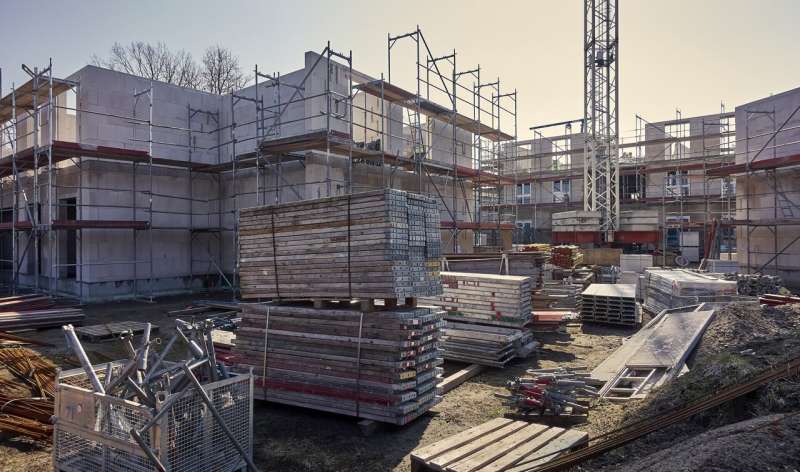This article has been reviewed according to Science X's editorial process and policies. Editors have highlighted the following attributes while ensuring the content's credibility:
fact-checked
trusted source
proofread
Study highlights tension between Canada's climate and housing goals

Canada cannot simultaneously meet its targets for emission reductions and new housing unless there's a drastic change in construction practices, according to research from the University of Toronto's Faculty of Applied Science & Engineering.
The study, published in Environmental Research: Infrastructure and Sustainability, found that if Canada is to stay within its emissions targets, homes built in 2030 will need to produce 83% fewer greenhouse gas emissions during construction compared to homes built in 2018.
"Our analysis shows that in 2018, which is the latest year for which we have the data, the construction sector in Canada was responsible for the equivalent of 90 megatonnes of CO2," says Shoshanna Saxe, an associate professor in the department of civil and mineral engineering and one of the senior authors of the study.
"That was about 8% of Canada's total emissions at the time, but we were not producing nearly as much housing as we needed then, let alone what we need now. To restore housing affordability, we need to triple the rate of housing construction by 2030."
At the same time, Canada's greenhouse gas emissions target for 2030 is to be 40% below 2005 levels, which works out to 443 megatonnes, Saxe notes.
"That means that unless things change, by 2030 nearly half of all the allowable emissions in Canada would be due to construction alone."
Saxe is the director of U of T's Centre for the Sustainable Built Environment (CSBE), which carries out research on the construction and urban design pathways that will enable Canada to meet its housing and infrastructure needs while curbing greenhouse gas emissions in line with the Paris Agreement, an international climate change treaty enacted in 2015.
The CSBE team's first step was to quantify the scale of the challenge—but they faced hurdles in gathering data on the construction industry's carbon footprint.
"What we found was that this data is split across many different parts of the economy: manufacturing, buildings, transportation, etc.," Saxe says. "There are also questions around consumption versus production: if a piece of steel is made in China and used for a building in Canada, whose emissions are those?
"Until now, it's been difficult to get a picture of the construction sector as a whole, which is partly why it's been overlooked."
Hatzav Yoffe, a post-doctoral fellow and lead author on the paper, used what's known as an environmentally extended input-output model to conduct a high-resolution, top-down analysis of Canada's construction sector.
The researchers calculated that residential construction was responsible for the largest share of total construction emissions, at 42%.
Their model also enabled them to ask another question: given the expected increase in housing construction, how much would emissions per constructed home have to decrease by in order to stay within emissions targets?
"You can't just take the overall 40% reduction target and apply that to the construction sector. That won't be enough, because you are also tripling the rate of housing construction," says Saxe.
The other members of the research team included Keagan Rankin, a Ph.D. student in the department of civil and mineral engineering, Daniel Posen, an associate professor in the department of civil and mineral engineering and Christian Bachmann, associate professor at the University of Waterloo.
While the study throws the tension between Canada's housing targets and its climate targets into sharp relief, Saxe and her colleagues believe it is still possible to reconcile the two—and are researching ways to tackle the challenge.
"For example, if you build more densely, you use fewer materials to build the same number of units. If you are strategic about where you place those units, you don't have to build as many new roads or sewers to service them," Saxe says.
"We can also think about changing the balance between housing construction and other types of infrastructure, such as oil and gas infrastructure.
"At the end of the day, if we're going to build what we need while avoiding the most catastrophic impacts of climate change, we need to seriously think about how we can deliver more with less."
More information: Hatzav Yoffe et al, Mapping construction sector greenhouse gas emissions: a crucial step in sustainably meeting increasing housing demands, Environmental Research: Infrastructure and Sustainability (2024). DOI: 10.1088/2634-4505/ad546a
Provided by University of Toronto



















